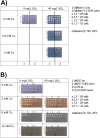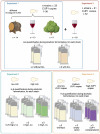Copper-based grape pest management has impacted wine aroma
- PMID: 38698114
- PMCID: PMC11066116
- DOI: 10.1038/s41598-024-60335-9
Copper-based grape pest management has impacted wine aroma
Abstract
Despite the high energetic cost of the reduction of sulfate to H2S, required for the synthesis of sulfur-containing amino acids, some wine Saccharomyces cerevisiae strains have been reported to produce excessive amounts of H2S during alcoholic fermentation, which is detrimental to wine quality. Surprisingly, in the presence of sulfite, used as a preservative, wine strains produce more H2S than wild (oak) or wine velum (flor) isolates during fermentation. Since copper resistance caused by the amplification of the sulfur rich protein Cup1p is a specific adaptation trait of wine strains, we analyzed the link between copper resistance mechanism, sulfur metabolism and H2S production. We show that a higher content of copper in the must increases the production of H2S, and that SO2 increases the resistance to copper. Using a set of 51 strains we observed a positive and then negative relation between the number of copies of CUP1 and H2S production during fermentation. This complex pattern could be mimicked using a multicopy plasmid carrying CUP1, confirming the relation between copper resistance and H2S production. The massive use of copper for vine sanitary management has led to the selection of resistant strains at the cost of a metabolic tradeoff: the overproduction of H2S, resulting in a decrease in wine quality.
© 2024. The Author(s).
Conflict of interest statement
The authors declare no competing interests.
Figures






Similar articles
-
QTL mapping reveals novel genes and mechanisms underlying variations in H2S production during alcoholic fermentation in Saccharomyces cerevisiae.FEMS Yeast Res. 2024 Jan 9;24:foad050. doi: 10.1093/femsyr/foad050. FEMS Yeast Res. 2024. PMID: 38124683 Free PMC article.
-
The impact of CUP1 gene copy-number and XVI-VIII/XV-XVI translocations on copper and sulfite tolerance in vineyard Saccharomyces cerevisiae strain populations.FEMS Yeast Res. 2020 Jun 1;20(4):foaa028. doi: 10.1093/femsyr/foaa028. FEMS Yeast Res. 2020. PMID: 32436567
-
SO2 and copper tolerance exhibit an evolutionary trade-off in Saccharomyces cerevisiae.PLoS Genet. 2023 Mar 28;19(3):e1010692. doi: 10.1371/journal.pgen.1010692. eCollection 2023 Mar. PLoS Genet. 2023. PMID: 36976798 Free PMC article.
-
Hydrogen sulfide and its roles in Saccharomyces cerevisiae in a winemaking context.FEMS Yeast Res. 2017 Sep 1;17(6). doi: 10.1093/femsyr/fox058. FEMS Yeast Res. 2017. PMID: 28830086 Review.
-
The Whiff of Wine Yeast Innovation: Strategies for Enhancing Aroma Production by Yeast during Wine Fermentation.J Agric Food Chem. 2019 Dec 11;67(49):13496-13505. doi: 10.1021/acs.jafc.9b06191. Epub 2019 Nov 25. J Agric Food Chem. 2019. PMID: 31724402 Review.
Cited by
-
QTL mapping reveals novel genes and mechanisms underlying variations in H2S production during alcoholic fermentation in Saccharomyces cerevisiae.FEMS Yeast Res. 2024 Jan 9;24:foad050. doi: 10.1093/femsyr/foad050. FEMS Yeast Res. 2024. PMID: 38124683 Free PMC article.
References
-
- McGovern P, Jalabadze M, Batiuk S, Callahan MP, Smith KE, Hall GR, Kvavadze E, Maghradze D, Rusishvili N, Bouby L, et al. Early neolithic wine of Georgia in the South Caucasus. Proc. Natl. Acad. Sci. U.S.A. 2017;114(48):E10309–E10318. doi: 10.1073/PNAS.1714728114/SUPPL_FILE/PNAS.1714728114.SD03.XLSB. - DOI - PMC - PubMed
-
- Darriet P, Bouchilloux P, Poupot C, Bugaret Y, Clerjeau M, Sauris P, Medina B, Dubourdieu D. Effects of copper fungicide spraying on volatile thiols of the varietal aroma of Sauvignon blanc, Cabernet Sauvignon and Merlot wines. Vitis. 2001;40(2):93–99.
-
- Barbosa R, Pontes A, Santos RO, Montandon GG, De Ponzzes-Gomes CM, Morais PB, Gonçalves P, Rosa CA, Sampaio JDSP. Multiple rounds of artificial selection promote microbe secondary domestication—The case of Cachaça yeasts. Genome Biol. Evol. 2018;10(8):1939–1955. doi: 10.1093/gbe/evy132. - DOI - PMC - PubMed
Publication types
MeSH terms
Substances
Grants and funding
LinkOut - more resources
Full Text Sources

